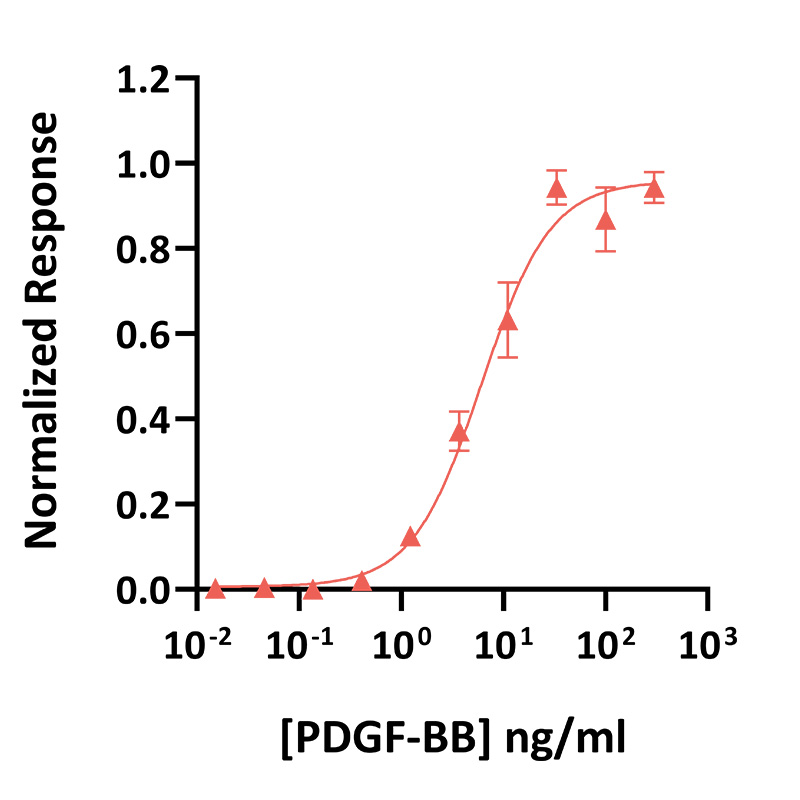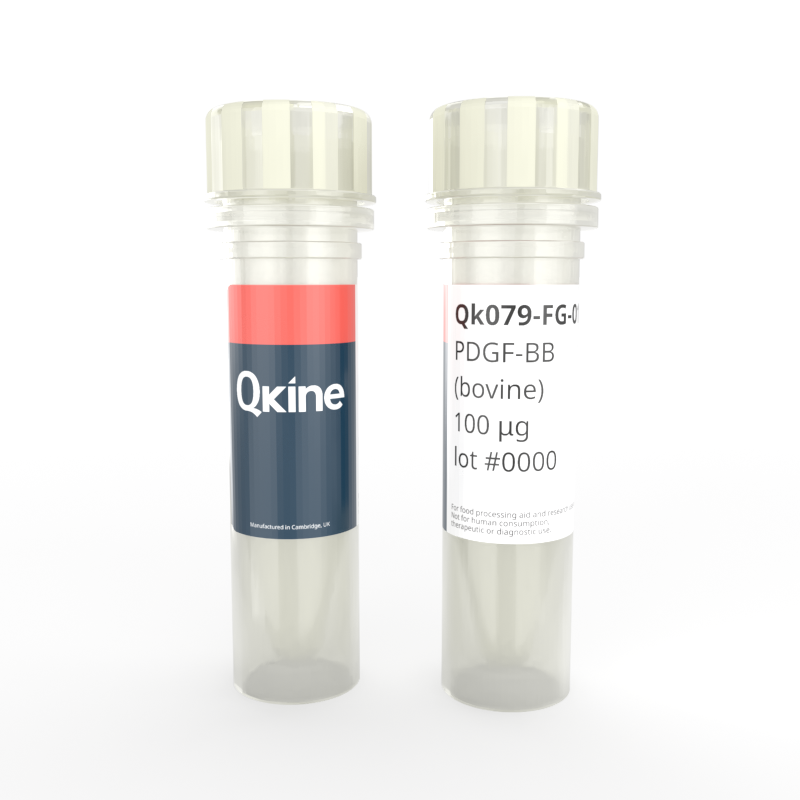 Recombinant bovine PDGF-BB protein (Qk079-FG)
Recombinant bovine PDGF-BB protein (Qk079-FG)Recombinant bovine PDGF-BB protein (Qk079-FG)
Price range: £230.00 through £2,900.00
Bovine PDGF-BB (platelet-derived growth factor BB) protein is a homodimer of PDGF-B peptide chains. PDGF-BB can be used for the development of optimized serum-free culture media for species-specific bovine in cellular agriculture protocols. PDGF-BB can be added to bovine culture medium to promote rapid and efficient cell division, maintain high cell proliferation rates in bioreactors, promote the maturation of bovine myoblasts into myotubes and stimulate the production of extracellular matrix components.
Qkine bovine PDGF-BB is a high-purity 24.5 kDa disulfide-linked bioactive dimeric protein that is animal origin-free (AOF) and carrier protein-free. Qkine has optimized the bovine PDGF-BB manufacturing process to produce a highly bioactive species-specific protein with excellent lot-to-lot consistency for enhanced reproducibility.
In stock
Orders are typically shipped same or next day (except Friday).
Easy world-wide ordering, direct or through our distributors.
Price range: £230.00 through £2,900.00
Buy online with secure credit card or purchase order. For any questions, please email orders@qkine.com
Summary:
- High purity bovine protein (Uniprot: B1H0W5)
- 24.5 kDa (monomer)
High quality food grade recombinant protein
>98%, by SDS-PAGE quantitative densitometry
Animal origin-free (AOF) and carrier protein-free
Expressed in E. coli
Manufactured in the UK under a food manufacturing HACCP regime
Lyophilized from acetonitrile, TFA
- Resuspend in sterile-filtered water at >50 µg/ml, add carrier protein if desired, prepare single use aliquots and store frozen at -20 °C (short-term) or -80 °C (long-term).
Featured applications:
Maintenance and expansion of bovine iPSC, ESC and primary cells
Proliferation of fibroblasts and smooth muscle cells
Cellular agriculture and cultivated meat cell culture media optimization
Serum-free media development

Recombinant bovine PDGF-BB activity was determined using a NFAT reporter assay in HEK293 cells co-transfected with the PDGF β receptor. Transfected cells were treated in triplicate with a serial dilution of bovine PDGF-BB for 6 hours. Firefly activity was measured and normalized to the control Renilla luciferase activity. EC50 = 5.4 ng/ml (221 pM).
Recombinant bovine PDGF-BB migrates as a band at approximately 14 kDa (monomer) in reduced (R) and as major band at approximately 27 kDa in non-reduced (NR) conditions. No contaminating protein bands are present. The purified recombinant protein (3 µg) was resolved using 15% w/v SDS-PAGE in reduced (+β-mercaptoethanol, R) and non-reduced (NR) conditions and stained with Coomassie Brilliant Blue R250.

Further quality assays
Mass spectrometry: single species with expected mass
Recovery from stock vial: >95%
Endotoxin: <0.005 EU/μg protein (below level of detection)
Full raw materials traceability, allergen analysis, CoO, CoA, beta-lactam-free and animal origin-free certification available
We are a company founded and run by scientists to provide a service and support innovation in stem cell biology and regenerative medicine. All our products are exceptionally high purity, with complete characterisation and bioactivity analysis on every lot.
Protein background
Platelet-derived growth factor-BB (PDGF-BB) is a significant growth factor involved in wound healing and development. It belongs to the PDGF family, which consists of four different polypeptide chains: PDGF-A, PDGF-B, PDGF-C, and PDGF-D [1]. These chains can form homodimers or heterodimers, with PDGF-BB being a homodimer composed of two PDGF-B chains linked by disulfide bonds [2].
PDGF-BB is a protein dimer with a molecular weight of 24.5 kDa. The structure includes a conserved cystine knot motif, which is crucial for its stability and function [1,2,3]. The dimerization of PDGF-BB is mediated by
specific disulfide bonds between cysteine residues. This dimeric structure is essential for its biological activity, enabling the molecule to effectively bind to its receptors [3].
PDGF-BB primarily functions by binding to PDGF receptors (PDGFR-α and PDGFR-β), which are tyrosine kinase receptors located on the cell surface. Upon binding, PDGF-BB induces receptor dimerization and autophosphorylation, initiating a cascade of downstream signaling pathways. These pathways include the PI3K/Akt, MAPK, and PLCγ pathways, which regulate various cellular responses such as proliferation, migration, survival, and differentiation [4].
PDGF-BB stimulates the proliferation and migration of fibroblasts and smooth muscle cells, promoting the formation of granulation tissue and the remodeling of extracellular matrix components [5]. PDGF-BB enhances angiogenesis by recruiting pericytes and smooth muscle cells to stabilize newly formed blood vessels [4.5].
In cultivated meat manufacturing, Platelet-Derived Growth Factor-BB (PDGF-BB) is essential for enhancing cell proliferation, differentiation, and tissue formation. During initial cell culture and expansion in bioreactors, PDGF-BB promotes rapid cell division, ensuring a sufficient cell mass. It aids in the differentiation of myoblasts into mature muscle cells and improves cell migration and integration within tissue scaffolds, resulting in more structured and functional meat tissue. PDGF-BB also stimulates extracellular matrix production, enhancing the structural and mechanical properties of the cultivated meat. By providing specific growth signals, PDGF-BB can reduce the reliance on fetal bovine serum (FBS), making the process more cost-effective and ethically acceptable. The role of PDGF-BB in cell growth and tissue engineering leads to more efficient production and higher-quality cultivated meat that closely resembles conventional meat in texture and nutritional content [6].
Our products are for research use only and not for diagnostic or therapeutic use. Products are not for resale.
For use in manufacturing of cellular or gene therapy products. Not intended for in vivo applications.

Receive an Amazon gift voucher when you leave us a review.
£25, $30 or €30 for reviews with an image and £10, $15 or €15 for reviews without an image
